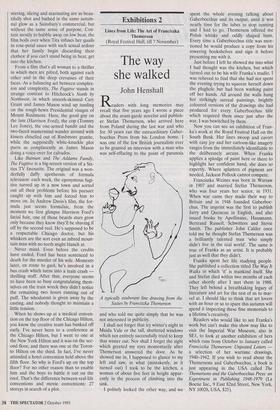Cinema 2
The Fugitive ('12', selected cinemas)
All woman
Mark Steyn
In America, Like Water for Chocolate is the year's highest-grossing foreign language film — though, to be honest, Spanish is less of a foreign language than, say, British English as spoken by the Merchant-Ivory guys with the marbles in their mouths. It's set on a remote ranch during the Mexican revolution of 1910, where men aren't much in evidence and few of the women miss them. 'It's worse', says one, 'to have chillis without water around' — the umpteenth culinary metaphor in a tale of suppressed passion finding an outlet in cooking.
Not the Hip and Thigh Diet either: these women are full-bodied, earthy, swarthy, fecund, etc. There are a couple of fellows to hand, but they're no more than passive love objects. The conflicts that power the drama are between Tita (a slowly simmer- ing Lumi Cavazos), her mother and her sis- ter, and the happiest gal is the one who rides off naked during on-horseback horse- play and becomes a revolutionary general. The production honours aren't dissimilar: adapted by Laura Esquivel from her novel, it's never more than competently directed by her husband, Alfonso Arau.
The novel includes recipes, and you wish the film had managed to find some cine- matic equivalent: as it is, the chopping and stirring, slicing and marinating are as beau- tifully shot and bathed in the same autum- nal glow as a Sainsbury's commercial, but without the same sense of purpose. Con- tent mostly to bubble away on low heat, the film boils over when Tita infuses her quails in rose-petal sauce with such sexual ardour that her family begin discarding their clothes: if you can't stand being in heat, get into the kitchen.
From a film that's all woman to a thriller in which men are pitted, both against each other and in the deep crevasses of their faces. As a balancing act between complex- ion and complexity, The Fugitive stands in strange contrast to Hitchcock's North by Northwest, in which smooth-skinned Cary Grant and James Mason wind up tussling on the rough-hewn Presidential visages of Mount Rushmore. Here, the good guy on the lam (Harrison Ford), the cop (Tommy Lee Jones), the one-armed bandit and the two-faced mastermind wander around with kissers chiselled out of Rushmore granite, while the supposedly white-knuckle plot purrs as complacently as James Mason doing a voice-over for calvados.
Like Batman and The Addams Family, The Fugitive is a big-screen version of a Six- ties TV favourite. The original was a won- derfully daffy apotheosis of formula television: each week, the eponymous fugi- tive turned up in a new town and sorted out all their problems before his pursuer caught up with him and forced him to move on. In Andrew Davis's film, the for- mula just seems formulaic, from the moment we first glimpse Harrison Ford's facial hair, one of those beards stars grow only because they know they'll be shaving if off by the second reel. He's supposed to be a respectable Chicago doctor, but his whiskers are the sort even an inbred moun- tain man with no teeth might blanch at.
Never mind. Even before the credits have ended, Ford has been sentenced to death for the murder of his wife. Moments later, en route to gaol, he's involved in a bus crash which turns into a train crash — thrilling stuff. After that, everyone seems to have been so busy congratulating them- selves on the train wreck they didn't notice the remaining two hours running out of puff. The whodunnit is given away by the casting, and nobody thought to maintain a little tension.
When he shows up at a medical conven- tion on the top floor of the Chicago Hilton, you know the creative team has bunked off early. I've never been to a conference at the Chicago Hilton, but I went to one at the New York Hilton and it was on the sec- ond floor, and there was one at the Toron- to Hilton on the third. In fact, I've never attended a hotel convention held above the fifth floor. So why is Ford's up on the top floor? For no other reason than to enable him and the boys to battle it out on the roof. That's the difference between real-life conventions and movie conventions: 27 storeys in search of a plot.



















































 Previous page
Previous page